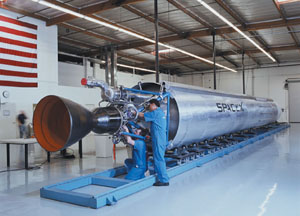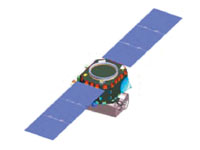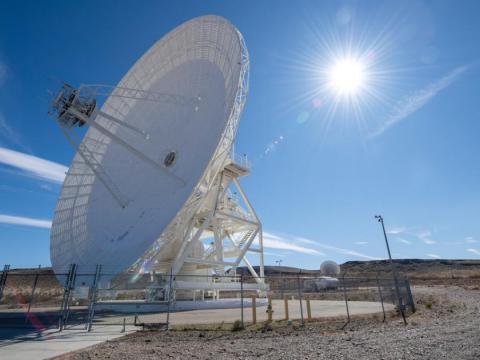Satellite Modularity Soars to New Heights

The U.S. Defense Department is working with Space Exploration Technologies Corporation to develop a family of less expensive, more reliable launch vehicles.
Concept changes the face and pace of military space-based asset deployment.
The final frontier is about to become home to another layer of military capabilities with the launch of TacSat-1 and lift-off of a new concept for space-based assets. The launch, which is scheduled for late this month, is the first step toward tactically exploiting space and represents a dramatic change of the entire business model for designing and purchasing space-based systems. Providing warfighters with operationally responsive satellite communications, the scheme will enable military commanders to act more quickly and effectively in battle.
Operationally Responsive Space (ORS) is a joint initiative that is being managed by the U.S. Secretary of Defense’s Office of Force Transformation, Arlington, Virginia. All four services are involved in developing the concept and participating in the experimentation. The U.S. Air Force is leading the effort.
Currently, commanders must rely on large military organizations to direct space-based assets and to provide the communications links they need for an operation. The ORS initiative seeks to condense this process by developing launch vehicles and payloads that can be manufactured and put into space faster, then making them available to operational commanders who can task them based on specific needs. The new systems would augment, not replace, larger existing communications satellite constellations as well as future space assets.
Col. Jay Raymond, USAF, transformation strategist, Office of Force Transformation, explains that traditionally all space assets have been high-technology, high-performance systems. “The Operationally Responsive Space concept shifts the value to speed, customization and agility. In this system, you may not get the splash, but it will be good enough to give commanders what they need, and they can task the satellites to do what they want. They will offer operationally relevant capabilities,” the colonel states.
The ORS concept includes several elements. First, it requires a launch capability that is less expensive to deploy and faster to employ. Second, the cost of the payloads must be reduced to allow planners to tolerate and even encourage risk taking. Col. Raymond relates that the payloads will be designed to last not 10 years but rather for a one- or two-year lifespan. In addition, the capabilities these satellites will feature will be demand-driven, based on requirements identified by commanders. Third, data translation rates will have to increase so operational commanders can take full advantage of the capabilities. Finally, additional metrics are being developed to assess the value of the effort, the colonel says.
These building blocks will enable constellations comprising many small satellites to be put into place to support a specific operation. For example, commanders preparing for a military offensive such as operation Iraqi Freedom would identify the communications capabilities they believe they will need. The satellites then would be launched within weeks or months rather than the years it takes today to put large constellations in position. Col. Raymond emphasizes that the additional space assets would complement existing capabilities and meet the needs of a specific theater of operations or provide additional links when a commander identifies the requirement for more robust communications capabilities.
Although the ORS did not start out as the impetus for a new business model, as the concept developed, it became evident that the concept had the potential to transform more than just how commanders operate or how new capabilities are put into orbit, the colonel says. To shorten the development cycle so the satellites could be launched to meet identified needs relatively quickly, the ORS team is developing standards for the satellite bus as well as modular interfaces for the payloads. Standards and modularity will go a long way toward being truly responsive to commanders, the colonel explains, because it will enable the pseudo-custom designing of satellites by allowing the needed equipment to be “pulled from the shelf” then plugged into the satellite to prepare it for launch.
These standards are one way to reduce cost and development time, the colonel notes, and the approach is likely to have a profound impact on the space industry as the focus shifts to developing modular instead of proprietary systems. “Traditionally, there have been standard buses. Across the industry, there have been attempts to standardize, but more needs to be done. We are going to pull together the experts and provide the resources to make this happen,” Col. Raymond states. One objective is to change the focus from the satellite to the payloads and find best of breed subsystems, he adds.
In addition to allowing more companies to compete for military space business, the ORS serves as a testbed for policy issues and technologies in an area that has become increasingly important: national security in space. It will offer a joint military space capability to complement the national intelligence capability. Command and control of these space-based assets will remain decentralized to respond to commanders’ needs. Finally, it enables a generational acquisition strategy because, as the development and launch time frame condenses, new capabilities can be inserted into the next satellites set to launch.
The ORS project is progressing in increments. TacSat-1 is built (SIGNAL, January 2004, page 47) and equipped with both infrared and visible-imagery cameras. The U.S. Pacific Command (PACOM), Camp H.M. Smith, Hawaii, will be experimenting with TacSat-1, the colonel says, and the lessons learned will be rolled into TacSat-2, which is scheduled for launch soon after TacSat-1 is put into space.
Although plans for the launches are moving forward, Col. Raymond notes that a need still exists for a smaller, less expensive launch vehicle. He reveals that the ORS team is working with Space Exploration Technologies Corporation, El Segundo, California, to develop a new booster. The company’s Falcon I flight vehicle will be used to put the TacSat-1 satellite into a 500 kilometer orbit. The firm was awarded an $8 million contract in September 2004 through the Defense Advanced Research Projects Agency and the Air Force to demonstrate a highly responsive, affordable launch capability. The demonstration is set to take place this summer, and the objective is to decrease on-pad processing time by a factor of two from the standard commercial Falcon I launcher.
 |
| TacSat-2 will incorporate lessons learned from TacSat-1 and will feature an improved specific-emitter identifier that requires one-tenth the wattage of the initial satellite. It will use the spacecraft bus that was ordered for the U.S. Air Force Research Laboratory's TechSat-21 demonstration, which was canceled. |
Another challenge that must be addressed is the location of launch sites. Today, the majority of satellites are launched from Vandenburg Air Force Base in California or from Cape Canaveral in Florida, the colonel explains. But putting satellites into space in the positions that will best support an operation could require more flexibility in launch locations. The effect new sites could have on the surrounding environment and populated areas is an issue that must be addressed, and the Air Force is doing a lot of work in this area, Col. Raymond says.
“Performance drives the location requirement for launching the satellites. There are places that support both polar and equatorial orbit launches from the same location. As this concept progresses and we get to the point where we want to have a satellite on alert, this requirement would drive the launch venues as well. We need to find a place with a full range of launch options,” the colonel maintains.
Although issues such as the effects of ORS on tactics and strategies and the location of possible additional launch sites still need to be resolved, planning is already underway for TacSat-3, which has been renamed Joint Warfighting Space. A series of experiments also is in the design stage. “We are working on and developing standards, and within a year, we will have the Joint Warfighting Space 3 bus. This is the first step for a standard interface. The next step would be to standardize the avionics package that the payloads require,” Col. Raymond explains. The Air Force Research Laboratory, New Mexico, is leading the work in this avionics package standardization area.
Because the ORS concept is shaped around the capability to build and launch new satellites quickly, the colonel predicts it also would be an effective tool to neutralize enemy attacks on space-based assets. If an adversary destroys one satellite, another could be launched immediately to restore the communications capability in a theater of operations relatively quickly, he explains.
“This is a testbed, so we can experiment with science and technology. At the same time, it supports the space professional development effort and will increase expertise in academia as we develop the concept,” the colonel notes.
Web Resources
Office of Force Transformation: www.oft.osd.mil
Operationally Responsive Space Experiment: www.oft.osd.mil/initiatives/ors/TacSat%20Fact%20Sheet.doc
A Concept of Operations and Technology Implications for Operationally Responsive Space: www.airpower.maxwell.af.mil/airchronicles/cc/brown2.html
Space Exploration Technologies: www.spacex.com



